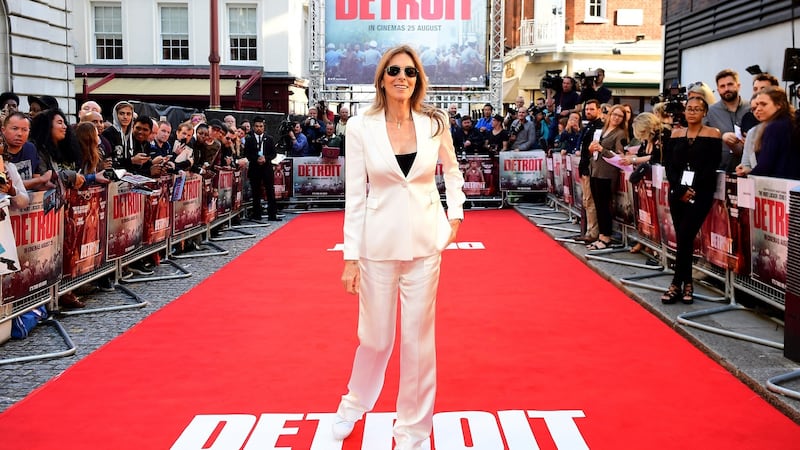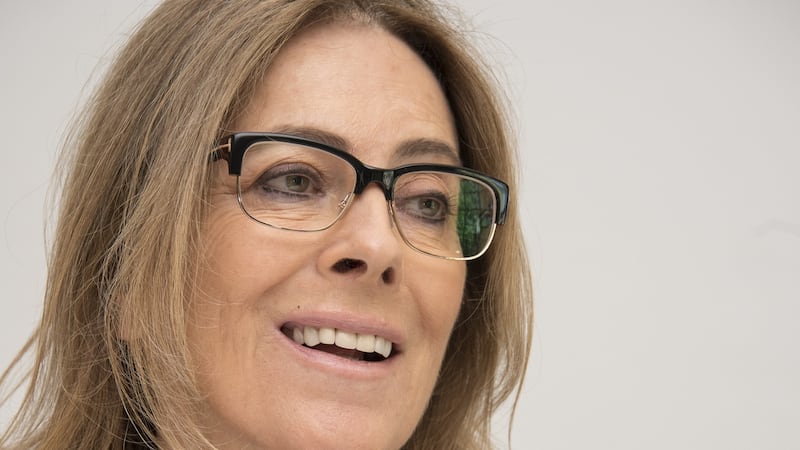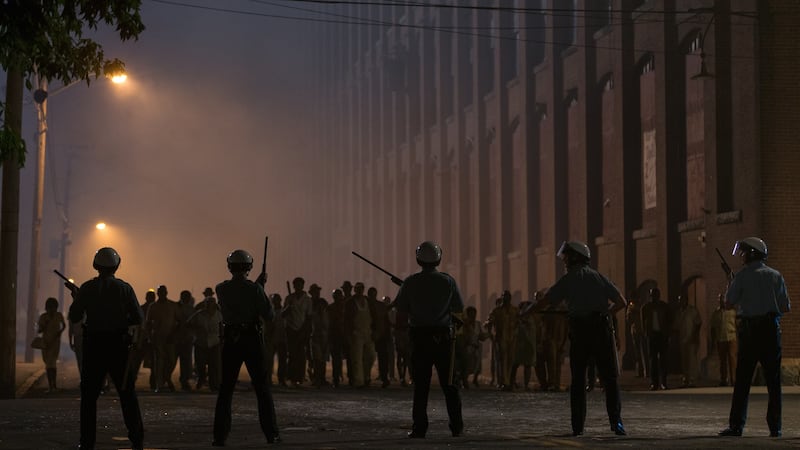"Are you okay with the sofa," Kathryn Bigelow says kindly. "I found that you sink right down in it. So I chose the chair."
By this stage it’s already too late. I’ve been sucked down several inches into its swampy embrace and find myself looking up at the already towering director. If she wants to tell me off then she has the ideal pulpit.
She doesn't. Bigelow, in a sunny mood today, has noted that she's talking to The Irish Times.

"You know Jack Reynor is in our film?"
I do of course. The young Irishman stands out in Bigelow's furious Detroit. He plays one of three cops who were implicated in the shooting of three young black men at the Algiers Motel during the riots that shook that city in 1967.
“He is a stunning actor,” she says. “He is just extraordinarily talented. I needed three actors to play three characters. I wanted them to work as a whole and have each be distinct at the same time.”
Now an implausible 65, Kathryn Bigelow – tall and lean enough to pass as recently retired athlete – is used to juggling controversy. Seven years ago, she became the first woman to win a best director Oscar when The Hurt Locker carried all before it. There was only moderate muttering at that film's apparent neutral position on the Iraq War. But Zero Dark Thirty triggered enormous unease with its blank, matter-of-fact depiction of torture.
The chatter this time has been less about the content of Detroit and more about the appropriateness of a white director telling the story. The riots broke out when the largely white police force busted an after-hours drinking club frequented by African Americans.
‘We need dialogue’
“I think racism hurts everyone,” she says. “It’s a human story. But I did debate with myself: am I the right person to tell this story? Probably not. On the other hand, I have the opportunity to tell this story and it’s a really important one. It’s sort of been secreted away. It’s topicality was too important to ignore. So I thought I should tell it. Racism really does hurt everyone and we need dialogue for that to change.”
The topicality Bigelow references is unavoidable. More than a few critics have noted that a bold subtext concerning Black Lives Matter runs throughout the picture. The unrest in Ferguson, Missouri highlighted the continuing racial iniquities in the republic. This past is still worryingly alive.
“How long you do you have?” she sighs. “Sadly the film seems even more relevant than I could have anticipated or imagined. The story presented itself around the time of Ferguson, Missouri and the decision not to indict the officer involved. The story of the Algiers Motel from 50 years ago felt shockingly contemporary and sadly indicates future potentiality.”

The film emerges two weeks after the apparent murder of a protestor by white nationalists in Virginia. The Civil War is ongoing.
“Looking at the events in Charlottesville, it is shameful that our administration refuses to denounce white supremacy,” she says. “I think systematic racism is something that needs to be challenged and stopped. If the film can contribute even in a small way to that dialogue then it will have fulfilled my aspiration.”
Point Break
Bigelow made her name with a series of action films in the late 1980s and early 1990s. Though indifferently reviewed at the time, Point Break, starring Patrick Swayze and Keanu Reeves as surfing hoodlums, is now seen as an untouchable classic of its genre. Blue Steel offered Jamie Lee Curtis a rare action role. At this point, Bigelow and her then husband, James Cameron, looked to be ploughing parallel furrows. (She was married to the director of Terminator from 1989 to 1991.) But her roots were in political and experimental art.
The daughter of solidly middle-class parents, Bigelow came of age in the Bay Area during the 1960s. She studied at the San Francisco Art Institute before going on to the film programme at Columbia University in New York City. What a time to be in those two cities. "But to be young was very heaven" and all that.
“It was pretty exciting to be part of a collective voice that stopped a war,” she says. “That was a real awakening for me. This can happen. I was out there marching against Vietnam. In the 1960s and early 1970s in New York it was a very charged time. I felt that collective voice would sustain itself. But now it feels tragically silent.”
That’s an interesting comment. The anger expressed through movements like Black Lives Matter suggests that many are still fighting to make radical voices heard. This is a very political time.
“It is a very political time. But there is an opportunity to change the calculus. To create a more equal society.”
Oscar win
Bigelow began as a painter before moving towards avant garde film. She explains that choice on a desire to "cross cultural lines". An early film features two men fighting while – in very Godardian fashion – semioticians deconstruct the images we were watching. Two low-budget, well-spaced features started to get her noticed. The Loveless from 1982 starred Willem Dafoe in an offbeat reverie that celebrated biker iconography. The wonderful Near Dark (1987) – still many aficionados' favourite Bigelow film – brought new flavours to the vampire film.
I imagine the young painter would have been very surprised to learn that she would grow into a commercial film-maker.

“I would probably have been very surprised,” she laughs. “That would be very surprising indeed. I thought when I was first studying art that I’d end up teaching art history. I did a postgraduate course in rococo and baroque painting. I found that fascinating. Then I began to discover film.”
She had many more struggles. There were gaps between films. The problematic Strange Days turned off a few critics. She made only three films in the first decade of the century. But that Oscar in 2010 secured membership of an exclusive club.
"I suppose that does change things," she says. "It's hard to say. I suppose it facilitated the opportunity to make a film like Detroit. In that sense it helped. We got a chance to make more journalistic films."
Bigelow had to endure two soap operas in the weeks before the Oscars. She had the pressure of potentially becoming the woman to direct a best picture winner. Then there was the matter of her main competitor. That year's battle was a two-horse race between The Hurt Locker and James Cameron's Avatar. The former husband and wife seemed to remain on good terms throughout the battle.
“I know! And the chances of that are virtually impossible,” she says. “I wouldn’t say any of that was a burden, but it was a bit surreal. He hadn’t made a movie in 13 years. I hadn’t made one in seven years. The chances were so slim. So surreal. Right up until the night, when my name was called, I didn’t know that was going to happen.”
When Barbra Streisand announced the winner in 2010, she began by saying "Well, the time has come…" It had. But no woman has been nominated since. Can Bigelow explain the continuing gender inequality in the field of directing? Is she sick being asked about it?
"I know, I know. There is such an inequity in the industry in terms of the ratio of women directors to men directors and of black directors to white directors and so on. At least people are now paying attention to it, thankfully. It's a shameful inequity and it has to change. It's hard to generalise. I don't know how the dynamic works. But there are a lot more women in every department. It's really that thrilling in Detroit we had a lot of women in the crew."
Living history
The film business is more insecure than ever. But, after an odd career, Bigelow seems to have settled on an unmistakeable brand. Her last three films – The Hurt Locker, Zero Dark Thirty, Detroit – combine her characteristically muscular action sequences with a journalistic bent to create living history. Can we expect that aesthetic to continue?
“Well, once you are working in a socially relevant space it’s hard not to sustain that…”
Something strange comes over me and I find myself asking as stupid a question as she has surely been asked all day. So she wouldn't do the next James Bond film then?
“Well, I don’t foresee that,” she says after a long pause. “But they do a wonderful job.”
She’s high above, but I don’t think she’s talking down to me.
DETROIT ON FILM
Once an industrial powerhouse to compare with any in the world, the great city of Detroit has undergone a notorious population decline over the last 50 years. But it continues to attract film-makers. Here are five examples.
BLUE COLLAR (1978)
Paul Schrader's directorial debut stars Richard Pryor and Harvey Keitel as autoworkers who plot to rob their corrupt union. Terrifically vital depiction of the working-class city. Great soundtrack.
ROBOCOP (1987)
Not for the last time, Detroit is used as the hub for a depiction of urban dystopia. Paul Verhoeven’s durable film puts a mechanical avenger among the villains.
8 MILE
There’s Michigan legend in the title alone. 8 Mile Road divides historically black and white sections of Detroit. It thus stands in as a neat symbol of what Eminem is up to in Curtis Hanson’s fictionalised biopic.
STANDING IN THE SHADOWS OF MOTOWN (2002)
We need a good drama on the rise of Motown records (the anaemic Dreamgirls doesn't count). Until then this cracking documentary on backing musicians The Funk Brothers will do very nicely.
ONLY LOVERS LEFT ALIVE (2002)
In recent years a string of excellent horror films have turned deserted Detroit into a new Transylvania. Jim Jarmusch's vampire romance joins It Follows and Don't Breathe in this odd genre.










